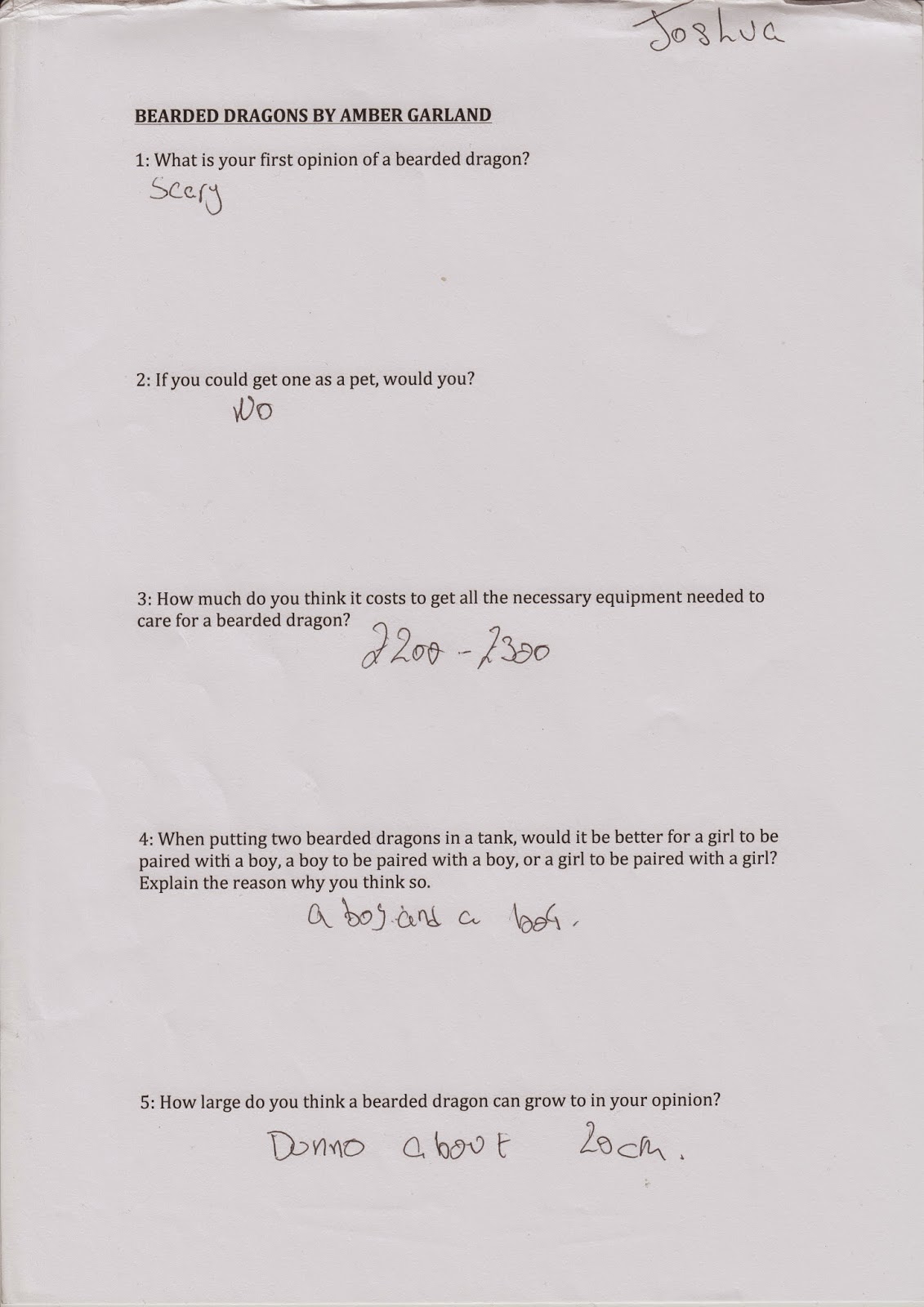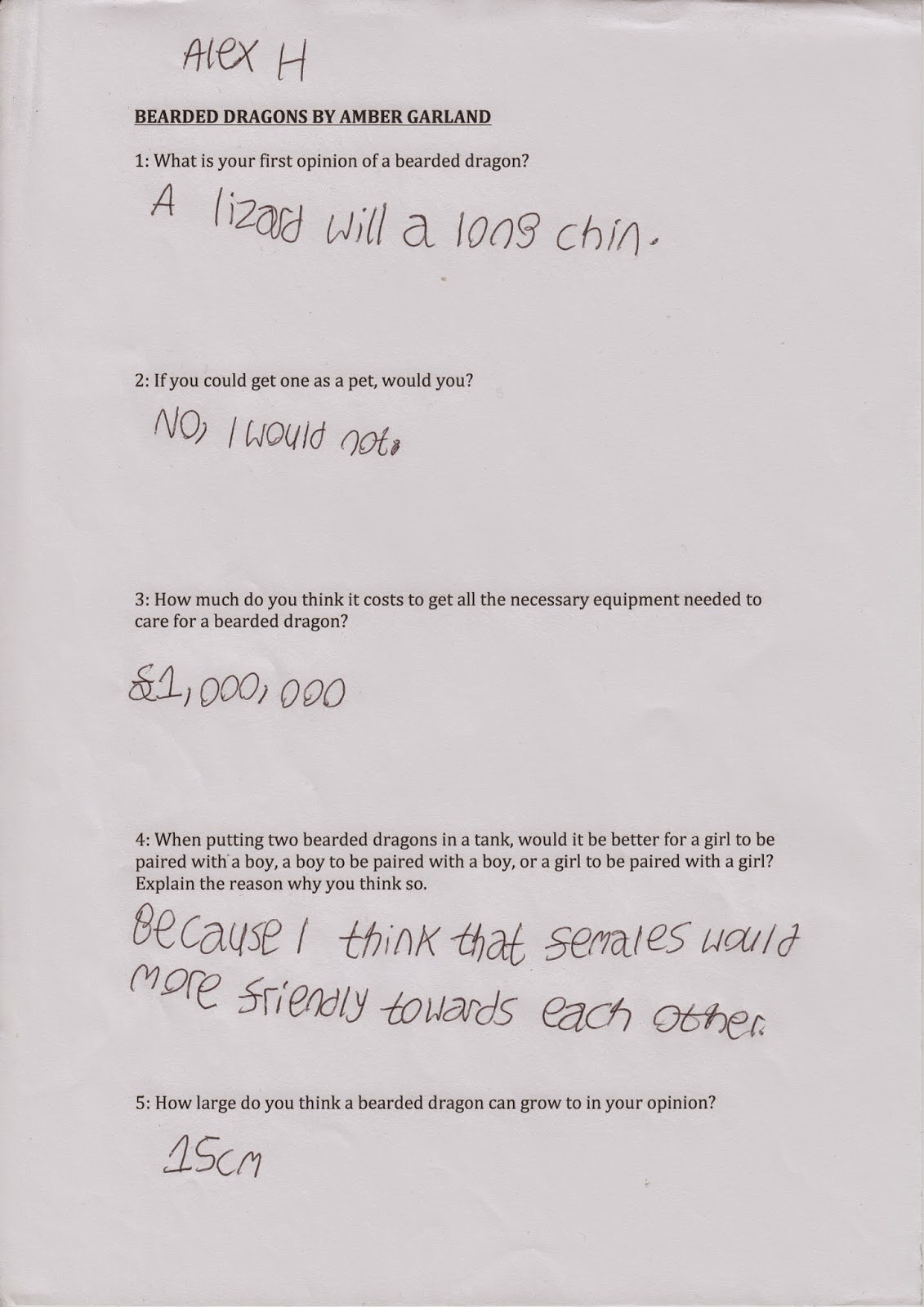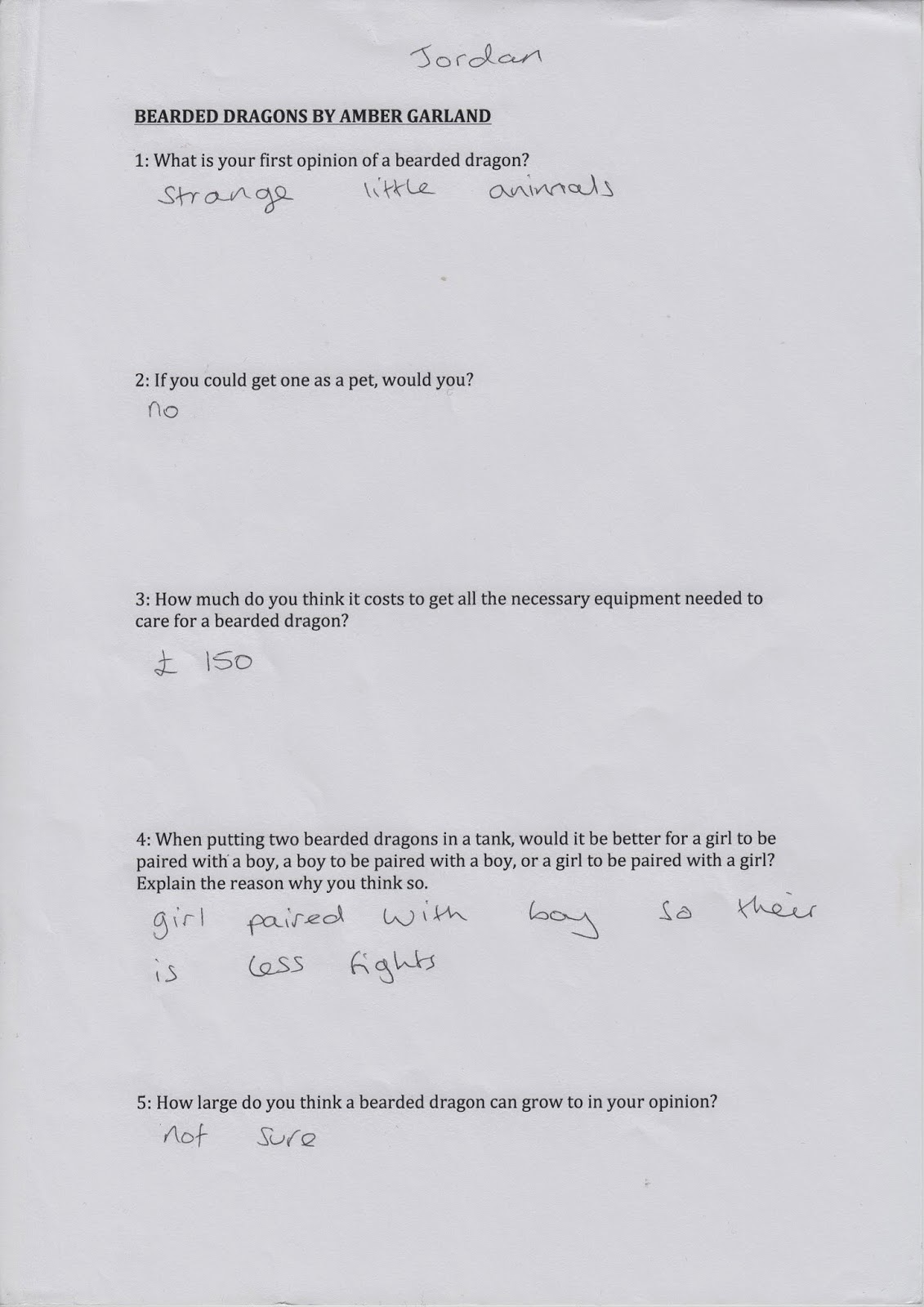Wednesday, 24 June 2015
Tuesday, 19 May 2015
Evaluation of bearded dragons documentary
My Overall project is a 4 minute long educational documentary about the life and habits of a bearded dragon. It is mainly aimed towards the audiences of children, although it can also be watched by an audience of promising lizard owners.
My finished project turned out very well, though, it isn’t the same as my original idea. I think that the change from idea to finished product turned out to be an exceptional change for the better. The finished product overall would have about 70% difference to the original idea that I came up with at the beginning. I feel very happy with my work and I am proud of how the overall video looks, I hope that audiences will enjoy it.
Through the pre-production process, I gathered various amounts of research based on a bearded dragons diet, characteristics and bodily form. I gathered fact files and video information on bearded dragons both to be informative and the gain further insight on more facts that I didn't even know about my bearded dragons. I did a storyboard on what shots I aimed to achieve for my production. I did this because I need to gain a mental understanding into the plan for my documentary.
Throughout the production, I gathered interviews from the likes of Jessica-Mae lee, Connor Winstanley, Rylan Hollingworth, Ellie Armstrong and my media teacher Michael O’Keefe. Each question asked was a personal question on the person’s opinion towards bearded dragons. I also acquired wonderful shots of my actors, the bearded dragons. I also gathered various different cutaways of the lizards in their vivarium and on their times in the bath and with family members. The casting wasn't exactly difficult because of the fact that the actors were my own pets. Through the production, I planned to use my own personal video camera.
Once I had finished filming the various scenes I needed I returned to Hyde Clarendon to begin the long process of editing and shot cutting. Each video encounter with my bearded dragons was about five minutes long though I only needed certain sections for the overall project. I used software called Final Cut Express to edit the raw footage of my lizards. The editing process took a matter of lessons to bring it up to its current glory. I used various transitions in my video such as crop zoom and dissolve to make the video smoother for my viewers to watch. Whilst sorting out the sound setting I used a special tool that would allow me to move the sound files audio balance in order to make it louder or quiet. Next, I gathered an H2 recorder to take my voice recordings since some of the raw audio footage from my documentary proved unusable. I then had to gather voice overs for my bearded dragons and also for my facts about lizards. I did this because I was giving my bearded dragons voices to appeal more to children. The voice overs for the lizards consisted of my teachers Andrew Findlay and Michael O’Keefe, as well as me. The voice overs for the facts were spoken by the voices of Adam Griffiths, Matthew Adderley, Paul Mather; Andrew Findlay, Michael O’Keefe, Jamie Apple-yard and Jake Lomas. All this editing was done in order to attempt to make my documentary look clean cut and professional.
In conclusion, I believe that I succeeded in making my documentary as great as it is now and I feel positive that it will be enjoyed by audiences on YouTube. I believe that my strengths throughout the documentary are that I gathered many various cutaways; views of my bearded dragons and then interview shots from people who I believe might be potential lizard owners. I also think that I did a great job choosing and creating the voice overs. I did very well on the entire editing process because I made it look as professional as possible.
Although I believe I made a few mistakes and these are my weaknesses. My camera quality was shifty throughout the entire process and the sound had noticeable flaws. The sound problems were solved by the power of subtitles. The entire problem was because of the videos being a little too quiet. At the beginning of the video, I made a small side note in which I apologized for the quality in which this video is made.
As of areas I could improve on, I believe that I could possibly improve on how to film my shots, which quality it should be set on for the cameras and also the time management in which I made this video. I also believe that I could do a little bit better on how I choose my shots for the videos so that they can be better.
Tuesday, 10 February 2015
Embedded clips based around my idea 4
This video features a form of dragon lizard, it has a similar appearance to that of the bearded dragon.
Though the Lizard has a strange defense mechanism. It squirts blood from its eyes to ward off enemies, the blood has repellents and poisons in that can also harm any enemies.
Though the Lizard has a strange defense mechanism. It squirts blood from its eyes to ward off enemies, the blood has repellents and poisons in that can also harm any enemies.
Embedded clips based around my idea #3
This video is based around how to hold and handle a bearded dragon. This is generally important because you could harm a lizard if hold it wrong.
Embedded clips based around my idea #2
This video is about baby dragons just being let into their first ever enclosure. this is also important because once the hatch you need to check for eggshell.
Embedded clips based around my idea #1
This video is about a pet shop that owns multiple bearded dragons of various shades and colors and genders.
I chose to pick this be cause i am also thinking to advertise my bearded dragons as well as speak about them
I chose to pick this be cause i am also thinking to advertise my bearded dragons as well as speak about them
Thursday, 5 February 2015
Paper based questionnaires for Bearded dragons
Paper based Questionnaires
These are questionnaires that i had given to my class to do with my bearded dragon research
Tuesday, 3 February 2015
Interviewee profile
Interviewees:
My friends
Jessica-Mae Lee
Age: 17
Gender: Female
An interviewee
Connor Winstanley
Age: 17
Gender: Male
An interviewee
Ellie Armstrong
Age: 17
Gender: Female
An interviewee
Rylan Hollingworth
Age: 17
Gender: Male
An interviewee
My Teacher
Michael O'keefe
Age: 48
Gender: Male
An interviewee
My friends
Jessica-Mae Lee
Age: 17
Gender: Female
An interviewee
Connor Winstanley
Age: 17
Gender: Male
An interviewee
Ellie Armstrong
Age: 17
Gender: Female
An interviewee
Rylan Hollingworth
Age: 17
Gender: Male
An interviewee
My Teacher
Michael O'keefe
Age: 48
Gender: Male
An interviewee
Monday, 19 January 2015
Johns not mad - An Analysis
Johns not mad - An Analysis
I am going to analyse the documentary 'Johns not mad'.
This documentary focuses on a sixteen year old boy with a 'tourettes syndrome', I am going to speak about the observational footage, the voice overs and the interviews presented throughout the documentary.
'Johns not mad' is in the format of a tv documentary that is in third person.
Observational footage
The main focus in the documentary is on the subject (John) we see various scenes in which John is in a public place with his tourettes on show to everyone. With these scenes we can see the public's view on the matter. The maker of this documentary did this purposely so that we see the subject in various environments, almost like watching animals in different habitats and recording the evidence.
One place that we see John is at the supermarket, this is one of the most populated places we see him. John is shown having various ticks and outbursts of curse words here and people are having trouble listening to the 'foul language' because they probably think it's directed towards them, it is obvious that the subject can't control or help himself here.
The next seen we see is John fishing by the river, where it's quoted that he is 'oddly quiet' when alone. The subject says that he is relaxed here and he secludes himself from other fishers on this river so that he doesn't have to be looked at or have attention put on himself.
The third place I've chosen to speak about is John's home, here John has a family that help him cope, apart from his father and grandmother.
Johns father avoids dinners at home sure to John's newfound tick, spitting. The fact John's father never joins has often broken the family a bit. Johns grandmother however, believes that John's condition is of the devil and he is 'possessed' from a scene like this, the audience tends to feel a lot of sympathy.
Interviews
Through the documentary we see a series of interviews that consist of views of the subject John, the witness John's mother, the expert Dr Oliver sacks and the second witness John's teacher.
When interfering each person we get a head-to-head shoulder and head-chest shot of them, we call these 'close ups'. The documentary's creator gives these shots a black background to give a sense of drama. Interviewing John we get quite a sympathetic feeling from what he says, and we get sense of how this effects him.
Next we interview John's mother. She is the main witness to John's condition, she speaks about how this condition has had an effect on her and others in the family. This is generally a dramatic interview because it shows the effect that tourettes has on people other than the main victim.
The second witness, John's teacher, speaks about how she deals with his tourettes, this helps us gain insight into the syndromes effect on people around the subject.
The last person interviewed was Dr Oliver Sacks, an expert on the tourettes syndrome itself. Dr Sacks spoke of the syndrome, telling us symptoms and giving demonstrations on ticks that John possibly had or may develop further in life.
Voice overs
Throughout the documentary we hear narration by a female figure, she gives the extra detail in the documentary and gives explanation towards John's tourettes syndrome.
I think that they picked a female to narrate this because she has a soft, slow voice and the voice can give sympathy to the subject of the documentary. I also think that it is because females have more empathy, sort of like a mother figure, they make the situation better.
Conclusion
As a conclusion I think that the documentary's creator decides to make the documentary as interesting and emotional as possible to both give awareness and pull at heart-strings of the targeted audience, they made this happen by using emotional music and scenes.
I am going to analyse the documentary 'Johns not mad'.
This documentary focuses on a sixteen year old boy with a 'tourettes syndrome', I am going to speak about the observational footage, the voice overs and the interviews presented throughout the documentary.
'Johns not mad' is in the format of a tv documentary that is in third person.
Observational footage
The main focus in the documentary is on the subject (John) we see various scenes in which John is in a public place with his tourettes on show to everyone. With these scenes we can see the public's view on the matter. The maker of this documentary did this purposely so that we see the subject in various environments, almost like watching animals in different habitats and recording the evidence.
One place that we see John is at the supermarket, this is one of the most populated places we see him. John is shown having various ticks and outbursts of curse words here and people are having trouble listening to the 'foul language' because they probably think it's directed towards them, it is obvious that the subject can't control or help himself here.
The next seen we see is John fishing by the river, where it's quoted that he is 'oddly quiet' when alone. The subject says that he is relaxed here and he secludes himself from other fishers on this river so that he doesn't have to be looked at or have attention put on himself.
The third place I've chosen to speak about is John's home, here John has a family that help him cope, apart from his father and grandmother.
Johns father avoids dinners at home sure to John's newfound tick, spitting. The fact John's father never joins has often broken the family a bit. Johns grandmother however, believes that John's condition is of the devil and he is 'possessed' from a scene like this, the audience tends to feel a lot of sympathy.
Interviews
Through the documentary we see a series of interviews that consist of views of the subject John, the witness John's mother, the expert Dr Oliver sacks and the second witness John's teacher.
When interfering each person we get a head-to-head shoulder and head-chest shot of them, we call these 'close ups'. The documentary's creator gives these shots a black background to give a sense of drama. Interviewing John we get quite a sympathetic feeling from what he says, and we get sense of how this effects him.
Next we interview John's mother. She is the main witness to John's condition, she speaks about how this condition has had an effect on her and others in the family. This is generally a dramatic interview because it shows the effect that tourettes has on people other than the main victim.
The second witness, John's teacher, speaks about how she deals with his tourettes, this helps us gain insight into the syndromes effect on people around the subject.
The last person interviewed was Dr Oliver Sacks, an expert on the tourettes syndrome itself. Dr Sacks spoke of the syndrome, telling us symptoms and giving demonstrations on ticks that John possibly had or may develop further in life.
Voice overs
Throughout the documentary we hear narration by a female figure, she gives the extra detail in the documentary and gives explanation towards John's tourettes syndrome.
I think that they picked a female to narrate this because she has a soft, slow voice and the voice can give sympathy to the subject of the documentary. I also think that it is because females have more empathy, sort of like a mother figure, they make the situation better.
Conclusion
As a conclusion I think that the documentary's creator decides to make the documentary as interesting and emotional as possible to both give awareness and pull at heart-strings of the targeted audience, they made this happen by using emotional music and scenes.
Thursday, 15 January 2015
Bearded dragons Diet
List of foods:
-Collard greens: High in calcium and giotrogens.
-Dandelion greens: High in calcium.
-Endive: Good when mixed with other greens, Also high in calcium.
-Carrot: Best to have the carrot tops, High in oxalates.
-Bok choy: Full of vitamin A.
-Turnip greens: Avoid feeding root, the greens are high in vitamin A, C and K.
-Alfalfa sprouts: Full of vitamins and minerals, difficult to eat.
-Strawberries: Excellent source of vitamin C.
-Figs: Usually dried, lots of calcium.
-Blueberries: A good source of vitamin K and antioxidants.
-Tomatoes: Lots of vitamin A and lycopene.
-Collard greens: High in calcium and giotrogens.
-Dandelion greens: High in calcium.
-Endive: Good when mixed with other greens, Also high in calcium.
-Carrot: Best to have the carrot tops, High in oxalates.
-Bok choy: Full of vitamin A.
-Turnip greens: Avoid feeding root, the greens are high in vitamin A, C and K.
-Alfalfa sprouts: Full of vitamins and minerals, difficult to eat.
-Strawberries: Excellent source of vitamin C.
-Figs: Usually dried, lots of calcium.
-Blueberries: A good source of vitamin K and antioxidants.
-Tomatoes: Lots of vitamin A and lycopene.
Bearded dragons documentary primary research
Primary research
- A female bearded dragon can give birth to around
about 50 eggs, but it is rare for all to survive. From personal experience the
mother gave birth from between 20-30 eggs and only 12-15 survived.
- When Bearded dragons shed their skin their eyes
bulge out so that it doesn’t cause them pain in that area.
-When bathing a lizard they are more likely to splash
about to try and get water onto their backs so they can clean themselves.
- Once it has been about 72 days, Baby bearded dragons
begin hatching from their eggs, though it takes about seven hours for them to
get out because it is exhausting.
- A baby bearded dragon is about the size of one
Monkey nut (not including the tail)
Information about Mutated bearded dragons
Mutation in Bearded dragons
a television show called freak show, this show is in Venice beach CA and they showcase their loved bearded dragon Pancho and Lefty. Though, Pancho and lefty isn't just any ordinary pet, ‘They’ are one of the few living mutated bearded dragons, that has managed to stay alive for longer than two years.
It is extremely rare to find a bearded dragon with this kind of deformity, since its two heads that share the same body and stomach and most likely the same heart.
It is extremely rare to find a bearded dragon with this kind of deformity, since its two heads that share the same body and stomach and most likely the same heart.
Subscribe to:
Comments (Atom)












